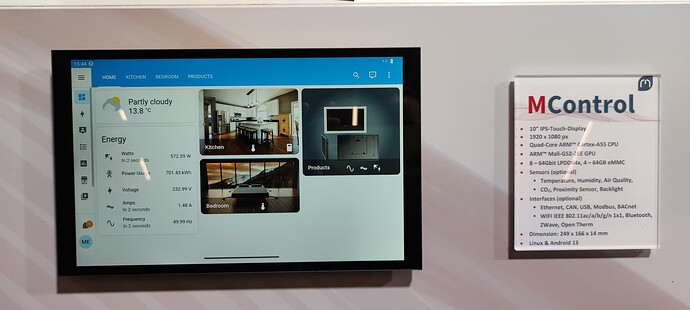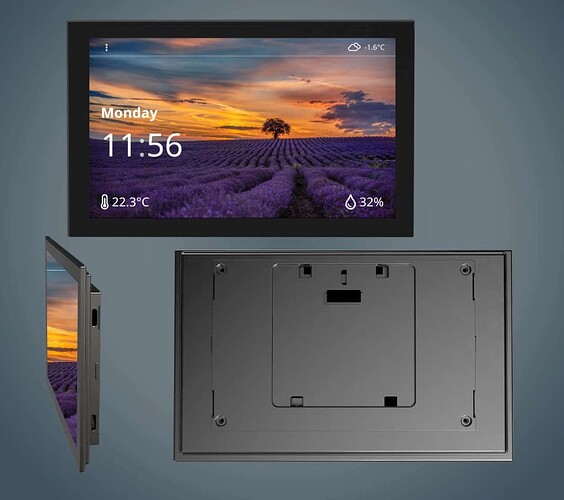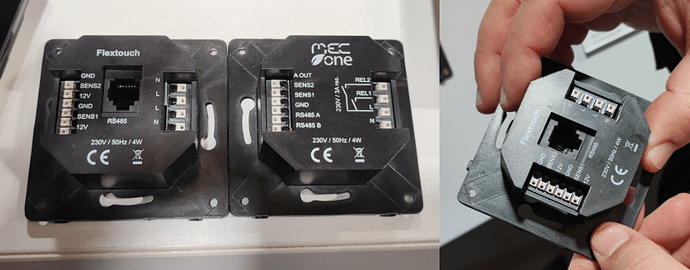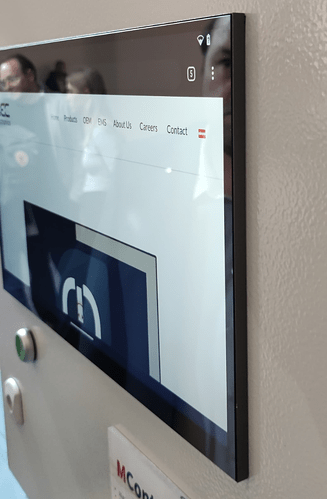There is an updated version with a different hardware!
Unfortunately, after the first meeting, MEC ELECTRONICS did not send me further information - maybe because my company is just me and too small for them? That is exactly what gives me motivation to continue!
Is the display from MEC ELECTRONICS the answer to many questions in the smart home sector? I think so. Because the devices are very well thought out, of high quality, and have a very appealing design.
What’s Special
Touchscreen Control Unit
The touchscreen is equipped with a powerful chip and can be operated with both Linux and Android. At Light and Building 2024, a variant was shown with Home Assistant directly „installed on the display.“ This naturally caught my attention because in this case, no additional server such as a Raspberry Pi, Intel NUC, or similar is needed. So it’s both a smart home control unit and IoT server in one device.
Wall Unit and Display Mount
But that’s not all. The display is intended for wall mounting and requires a corresponding flush-mounted device for power supply and network access via LAN. MEC ELECTRONICS can optionally integrate additional features into this flush-mounted device as desired.
Built-in Relays & Sensors
The shown wall unit is equipped with additional actuators and sensors. The two relays can be used to control lights, blinds, or heating. There are also inputs from sensors, such as temperature, humidity, air quality, CO2, light intensity, etc., which can be used individually according to project requirements.
Different Sizes
The multifunctional displays are available in different sizes:
4″, 5″, 7″, 10″ IPS Display
The wall unit remains the same for the displays, so a larger display can also be installed later upon customer request. (Only the 10-inch display requires a different wall unit for stability).
Customizable Interface
The interface can be adapted to any requirements. Here in the video, you can see the variant as a complete room control unit, regulating temperature and controlling lighting. Various sensors are also displayed on the surface, and I find the control concept with swipe gestures very intuitive.
The video mentions that Apple HomeKit has been integrated here and the colored LED lamp is addressed via Z-Wave!
Particularly Slim Design
I particularly liked the variant with the very slim design, and I can imagine this display very well in upscale residential construction. At the fair, it was shown how it is used as a control unit for an industrial control cabinet.
Also Available with Integrated Smart Home Hub
Absolutely revolutionary is also the option to add a smart home standard to the wall unit on request, turning the device into a full-fledged smart home hub. The Z-Wave variant was shown at the fair. However, there are also versions for DALI, KNX, and Open Therm. It is also conceivable that Zigbee and of course Matter will be supported in the future.
My recommendation is to use the Z-Wave variant because this standard has been developed over the past 10 years and is therefore very reliable and mature. Debugging larger Z-Wave networks is also possible with professional software tools. Similar „tools“ for Zigbee are rare or nonexistent.
In Detail
Smart Home Hardware
A Z-Wave chip is built into the wall unit. This Z-Wave chip serves as the central control and coordination element for all other Z-Wave devices such as plug sockets, dimmers, roller shutter switches, door sensors, etc.
Communication with Home Assistant
Home Assistant recently joined the Z-Wave Alliance: Nabu Casa joins the Z-Wave Alliance - Home Assistant. Accordingly, the setup is also easy because the Z-Wave chip is automatically detected by the system and is ready for use with a few clicks.
Adding More Z-Wave Devices
Thanks to QR Smart Start, Z-Wave is a very system integrator-friendly standard, and adding new devices can also be done remotely.
Control and Automations
Control and creating automations, scripts, scenes, etc., then seamlessly goes through Home Assistant. The new devices are visible on the interface and can be used directly.
Significance for Builders and Investors
Which System?
The question of which smart home system to use, which standard is right, and what will ultimately prevail is extremely complex and cannot be answered in a blanket manner. Every project is unique, every building has its peculiarities, and the requirements of the users vary depending on the target group. At the same time, the requirements for the system change over the years.
Therefore, my answer to this question is: Choose a system that supports all standards! From wired KNX systems to common wireless standards like Z-Wave, Zigbee, Homematic, EnOcean, LoRa, to end-consumer-friendly new standards like Matter & Thread.
Keeping Investment and ROI in Mind
The current figures for building permit applications for new buildings show that it is currently extremely difficult to implement profitable projects. The classic „concrete management“ is, in my opinion, no longer profitable. For example, you can expand your business areas with services close to living and corresponding services, possibly with solutions for Germany’s aging society (Assisted Living). At the same time, the system should be flexible so that you can respond quickly and effectively to new requirements.
Planned & Smart Home Ready
From a planning perspective, you only need a normal flush-mounted box with NYM-J cable 3x1.5 mm² for power supply, a network cable for access to the network, and optionally a KNX bus cable.
Further IoT Requirements
The smart home system is not the end. Users also want a video doorbell and possibly some video surveillance, a visualization for renewable energies, and so on. In addition, there are complex requirements for data protection, and not everything should be shifted to the cloud. Voice control is also a topic; this should also work locally without internet access.
Climate-Efficient Building
For non-residential buildings, the legislature has set the course with the Building Energy Act (GEG), and the requirements for a climate-efficient building from the perspective of automation and communication with heating, air conditioning, heat pump, energy storage, electricity meter, etc., are far from uniform standards. This increases the requirements for the system integrator and the implementation of complex automations.
Solution
Multifunctional Hardware
With this all-in-one device, not all, but at least a large part of the requirements are met.
You get:
- Display and control unit
- Multi-protocol smart home
controller - Various sensors and actuators
- Open infrastructure thanks to Linux
Multifunctional Software
Thanks to the Linux infrastructure, you can decide for yourself which software to use. If for any reason you want to change the software after a few years, it can be done easily without having to replace the entire hardware.
Masters and Templates
With Home Assistant, it is possible, for example, to prepare a standard living unit with heating, lighting, shading, air conditioning, various sensors such as presence and motion, as well as a video intercom, etc., in software and use this as a template for the other displays.
With our templates/blueprints/logic blocks, complex automations can be created across manufacturers and trades with just a few clicks.
Collaboration
If you are planning a smart home project, let’s discuss the various possibilities and advantages that Home Assistant and MEC ELECTRONICS displays offer you.
Specialization: Assisted Living
For many years, I have been focusing on technical assistance systems that support both relatives and those affected in leading a self-determined life for as long as possible.






